I must be overlooking something but I really don't see the need to have a bulk terminal. I am studying the body effect whereby it somehow interferes with the threshold voltage. I don't fully understand it because I'm finding creating the terminal in itself counter intuitive.
I am told that it must be connected to the lowest or highest voltage in a circuit, depending on n or p channel. First of all, if this interferes with the threshold voltage, wouldn't my supply rails directly interfere with the mosfet since they could be 1V or 15V. Not to mention if there was noise in the power supply, it would directly transmit through, no?
What would happen if there was no body terminal?
Why does a BJT not need one?
Do enlighten me.
